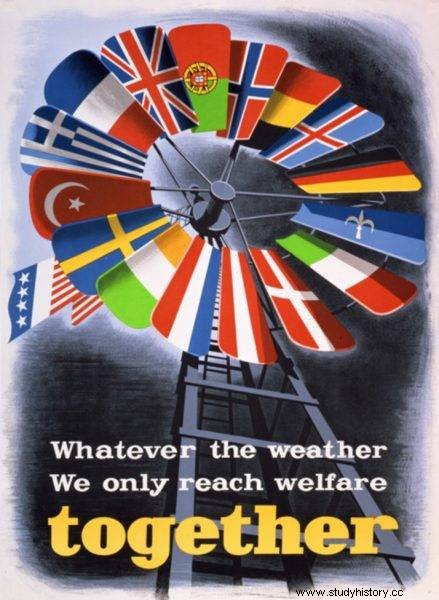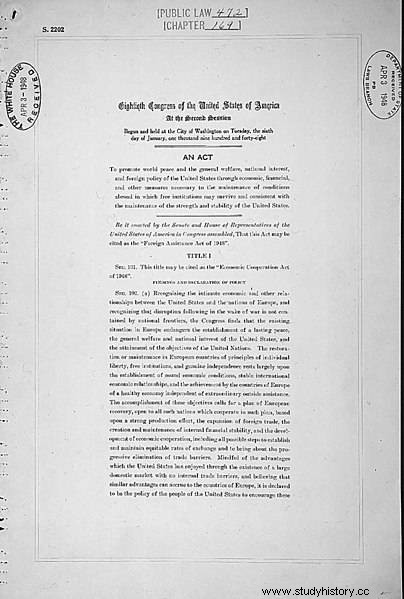World War II left many European countries in ruins. This was understood in the US and it was decided to create a program that would contribute to their economic recovery. However, it was not only about the economy and the standard of living of the population. For, in the East, the recent ally was beginning to increasingly become a threat, both to Europe and to the United States itself.
Origins and principles of the Marshall Plan
On June 5, 1947, in his speech at Harvard University on the occasion of the end of the academic year, US Secretary of State George Marshall outlined the principles of the Plan. He stated that:
"The United States should do whatever it can to help a world return to normal economic health, without which there will be no political stability and lasting peace. Our policy is not directed against any state or doctrine, but against hunger, poverty, desperation and chaos a Any government willing to help with the reconstruction task can count on full cooperation, I am sure, from the US Government . " At the same time, he made a reservation that " any government that manipulates to block the reconstruction of other countries cannot expect help from us." Moreover, governments, political parties or groups that seek to prolong human suffering for political or other gain will face opposition from the United States. " .
Especially the last sentence may bring to mind the attitude of the USSR towards the Plan, but more on that later.

George Marshall (1880-1959), United States Secretary of State (1947-1949)
We will not present here in detail the path that led to the crystallization of the assumptions of the Marshall Plan, because that would be enough for a separate article. Let us also remember that this was not the first form of US aid for war-torn Europe, let's mention for example the "aunt UNRRA", so well-known in Poland. .
Even before the adoption of the Marshall Plan, a preparatory conference was held in Paris on June 27 - July 2, 1947. The proper conference took place shortly thereafter, between July 12 and September 22, also in Paris. Apart from the USSR, Spain was also not invited. Eventually, the plan was named European Recovery Program . It covers the following European countries:Austria, Belgium, Denmark, France, Greece, the Netherlands, Ireland, Iceland, Luxembourg, Norway, Portugal, Switzerland, Sweden, Turkey, Great Britain and Italy. Why is there not a single country from the Eastern Bloc among them?
Several goals have been set for the above-mentioned countries. They were to create an international organization that was to implement the Plan, agree on the terms of distribution of this aid and remove the existing barriers to trade. Moreover, in addition to preparing a program of economic recovery, they were given the task of achieving self-sufficiency by 1952 .

One of the posters promoting the Marshall Plan in Europe. The white and blue flag between the flags of Germany and Italy is one of the versions of the flag of the Free Territory of Trieste
Ultimately, Great Britain gained the most from the Marshall Plan - as much as USD 3.4 billion. This was followed by France (2.8 billion), Italy and Germany (about 1.5 billion each), which were later added to the program. In total, the US allocated approximately $ 13 billion to aid under the Marshall Plan in 1948-1952.
The political implications of the Marshall Plan
In the political context, the Marshall Plan became a stimulus for subsequent European integration. Let us remind you:Europe was supposed to create an appropriate organization that would allow the program to be implemented. The Organization for European Economic Cooperation (OEEC), established on April 16, 1948, became such an organization. This organization, however, had no political ambitions, so it did not transform directly into something like the ancestor of the European Union, which only became the European Coal and Steel Community. The fact is, however, that the OEEC lived up to the hopes the Americans had in it . It is also worth mentioning another institution established in those years - the European Payment Union, under which a system of multilateral settlements was introduced.
Germany has also become part of the US European puzzle. President Truman's administration rather quickly opted for a pragmatic approach here, as Germany (and its economic potential) was an element needed to counterbalance the Soviet Union's influence in Europe. J In 1946, Directive 1067 (introduced by the Joint Chiefs of Staff), which recognized Germany as an enemy country, was abandoned . On January 1, 1947, Bizonia was born from the American and British occupation zones. On October 31, 1949, Germany was already fully-fledged in the work of the OEEC Council.

Investments in West Berlin from the Marshall Plan
Restraining the growing influence of communism in Western European countries may not have been the primary goal of the Marshall Plan, which does not mean, however, that the United States ignored this problem. Rather, they saw it as a potential long-term threat to themselves. Communist influence was especially fertile in France and Italy. In the first, by 1947, over 900,000 new members of the local Communist Party arrived, while in Italy - as many as 2 million. This number was even greater than in Poland. One of the administrators of the Marshall Plan, Paul Hoffman, believed that communism would spread where there was hunger and that the way to overcome it was the welfare of society .
However, while the exertion of direct influence by the USA in the case of France and Italy led, inter alia, until the ministers of communist parties were dismissed from government, the support expressed for these parties in the elections did not decline as quickly as could be expected. For example, the French Communist Party won 28.2% of the vote in 1946, and 10 years later this figure fell slightly to 25.9%.
Why has Poland not benefited from the Marshall Plan?
The answer to this question could be summed up in two words:"because the USSR", although it would be a simplification. The USA had a dilemma here, whether and to what extent to extend the potential aid program to the states of Central and Eastern Europe, and the USSR itself? There were fears that a powerful neighbor would force the countries behind the Iron Curtain to give up the benefits of the plan, which unfortunately turned out to be prophetic . In Moscow, the Marshall Plan was seen as a potential threat. He was associated with the Truman doctrine, famous in those years, which in this case could have been targeted against this country.
Nevertheless, the Soviet Union wanted to collect information about the plan and about the attitude of the most important countries of the Eastern bloc towards it. The Soviet Ministry of Foreign Affairs, through its embassies, even recommended that the leaders of Poland, Czechoslovakia and Yugoslavia present their views on the subject. Both Czechoslovakia and Poland had high hopes for participating in this initiative, and both countries were initially very active in this field and informed the USSR of their interest in the Marshall Plan. Romania and Hungary, for example, were also interested in participating.

One of the administrators of the Marshall Plan, Paul Hoffman, believed that communism would spread where there was hunger, and that the way to overcome it was the welfare of society
Moscow, however, remained silent. Neither Poland nor Czechoslovakia received a reply to their diplomatic notes. The USSR delegation led by Molotov arrived at the preparatory conference in Paris on April 26. She expected information on the amount of planned aid, and at the same time claimed that the implementation of the program could lead to interference in the internal affairs of individual countries. At the same time, it was objected to equal treatment of European countries, suggesting that the aid should be granted mainly to those that suffered as a result of the German occupation.
After opposing the various solutions proposed, inter alia, by Great Britain and France, the delegation of the USSR departed. The Soviet Union certainly did not like any international control over the program that prevented it from "laying a hand" on the money allocated to the Eastern Bloc countries and that participation in the Marshall Plan would require transparency in presenting the real economic condition of these countries, including in the context of the living conditions of the population.

Front page of the Foreign Assistance Act of 1948 - Marshall Plan Act
What about the participation of other Eastern bloc countries in the Marshall Plan? State delegations were originally instructed to show the flaws in the program and eventually leave the deliberations as well. Stalin himself decided, however, that on July 7, the TASS agency announced that Poland and Yugoslavia were rejecting invitations to the proper conference in Paris. On the night of July 7-8, the diplomatic missions of all satellite states received information that the USSR would prefer to give up this part of Europe from participating in the Marshall Plan. Subsequent countries followed the only correct line and officially rejected their participation in it. Originally the invitation was accepted by Czechoslovakia, but pressure from the USSR forced the delegation and that country to withdraw from this decision .
Although at the time of the outbreak of the war in Korea there was a certain reevaluation of American policy, including in the field of aid provided to Europe, the Marshall Plan to a large extent put the countries of our continent on its feet. Or at least those who could benefit from it. It only remains to wonder how economically Poland could be if it also had the opportunity to participate in this program.
Bibliography:
- Bartoszewicz, Changes in the European policy of the Soviet Union in the second half of 1947 ., "Kwartalnik Historyczny", no. 3/1998.
- Jezierski, C. Leszczyńska, Economic history of Poland , Key Text Publishing House, Warsaw 2003.
- Kowalski, The Marshall Plan. Economic and political conditions and effects , Publishing House of the University of Lodz, Lodz 2014.
- Madej, Marshall Plan , "IPN Bulletin", No. 10-11 / 2007.
- Podraza, European integration and the redefinition of US foreign policy:reasons for initiating and developing transatlantic security relations in 1945–1948 , "Yearbook of European Integration", No. 10/2016.
- Szatlach, The role of the Marshall Plan in the initial period of the institutionalization of European integration , "World of Ideas and Politics", vol. 4/2004.
